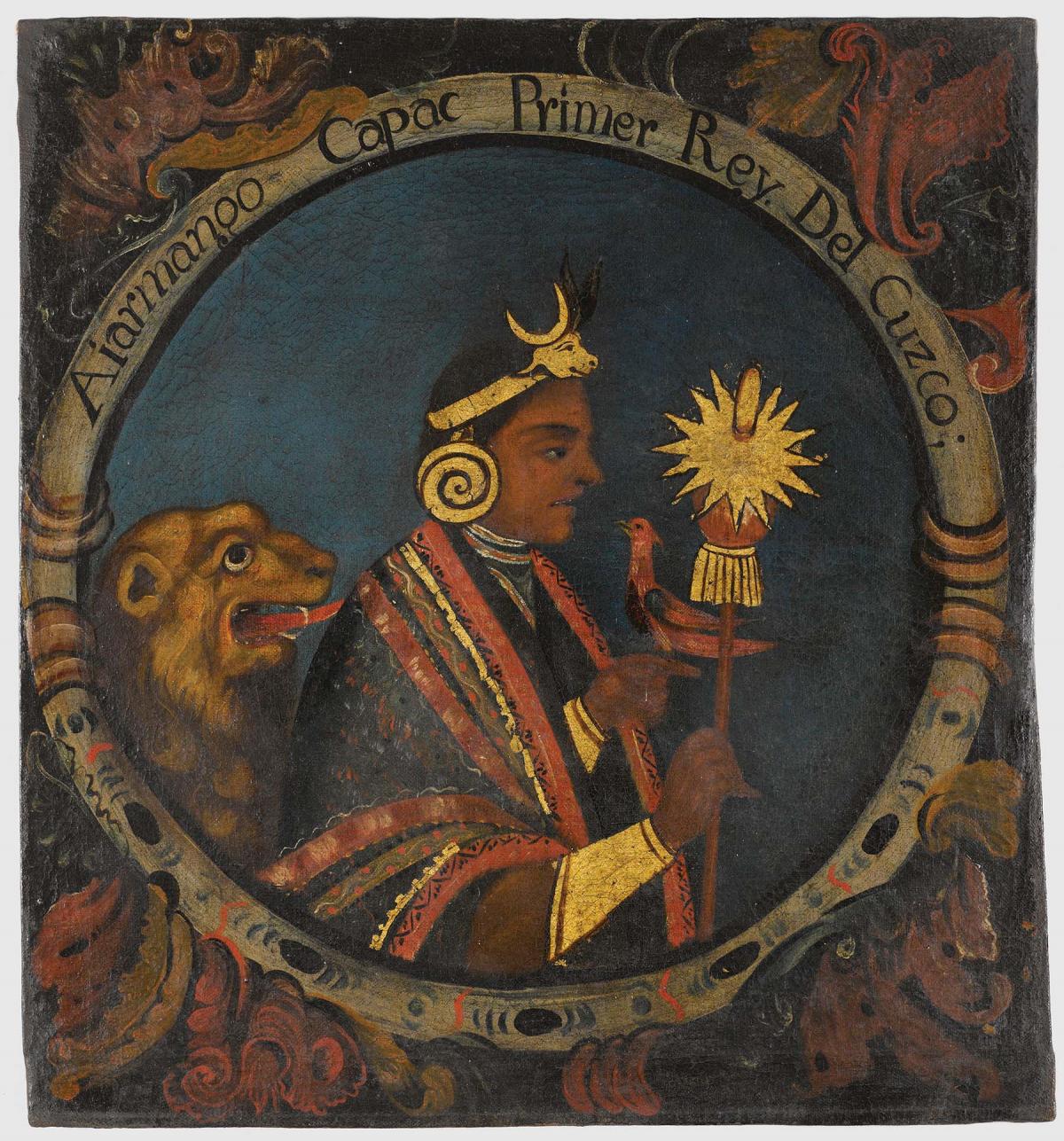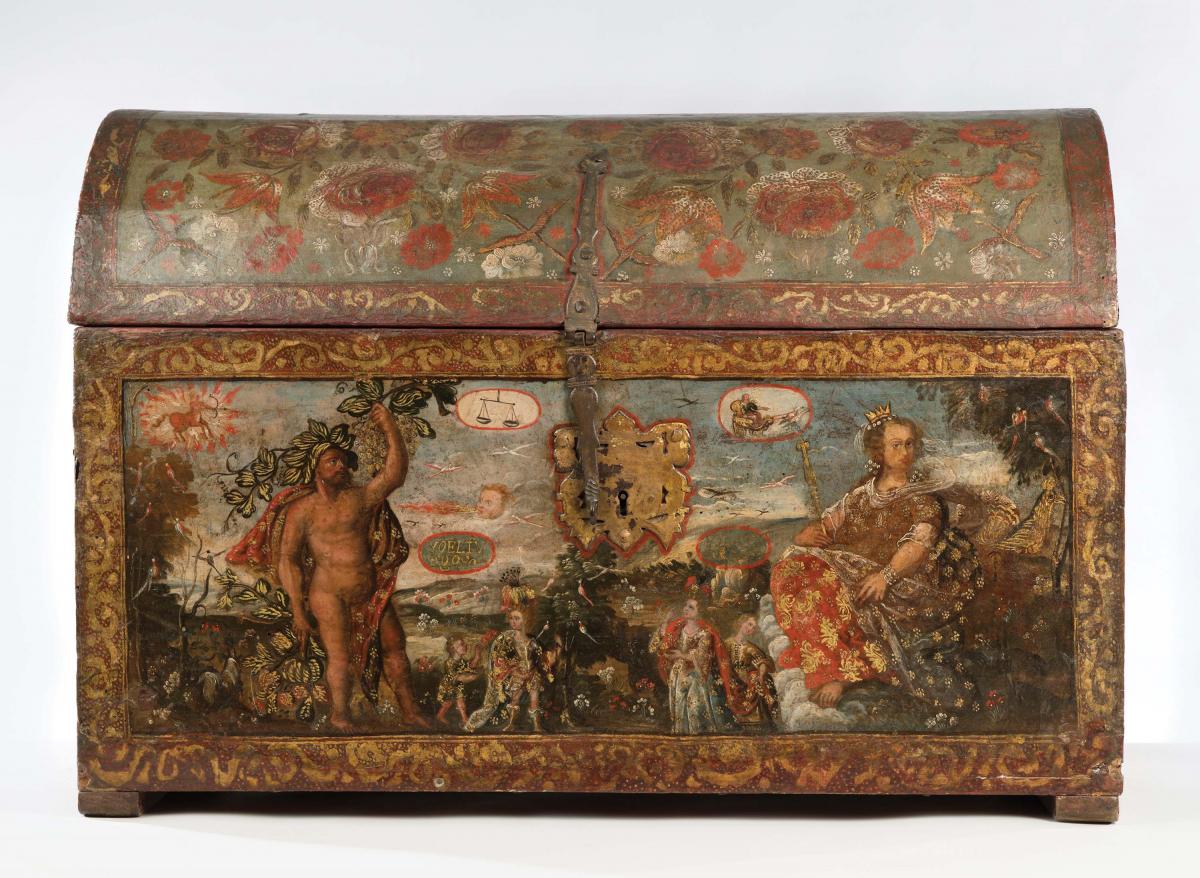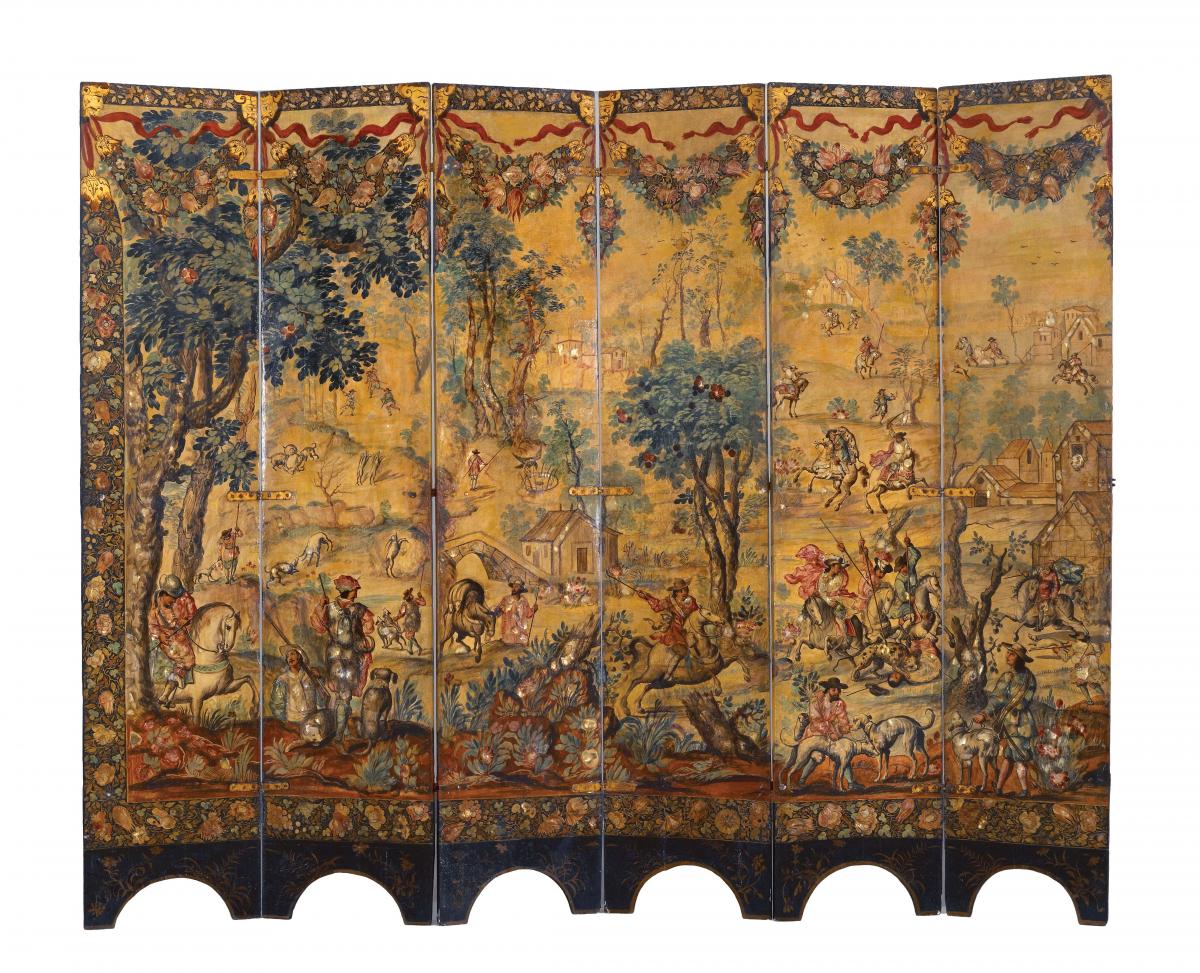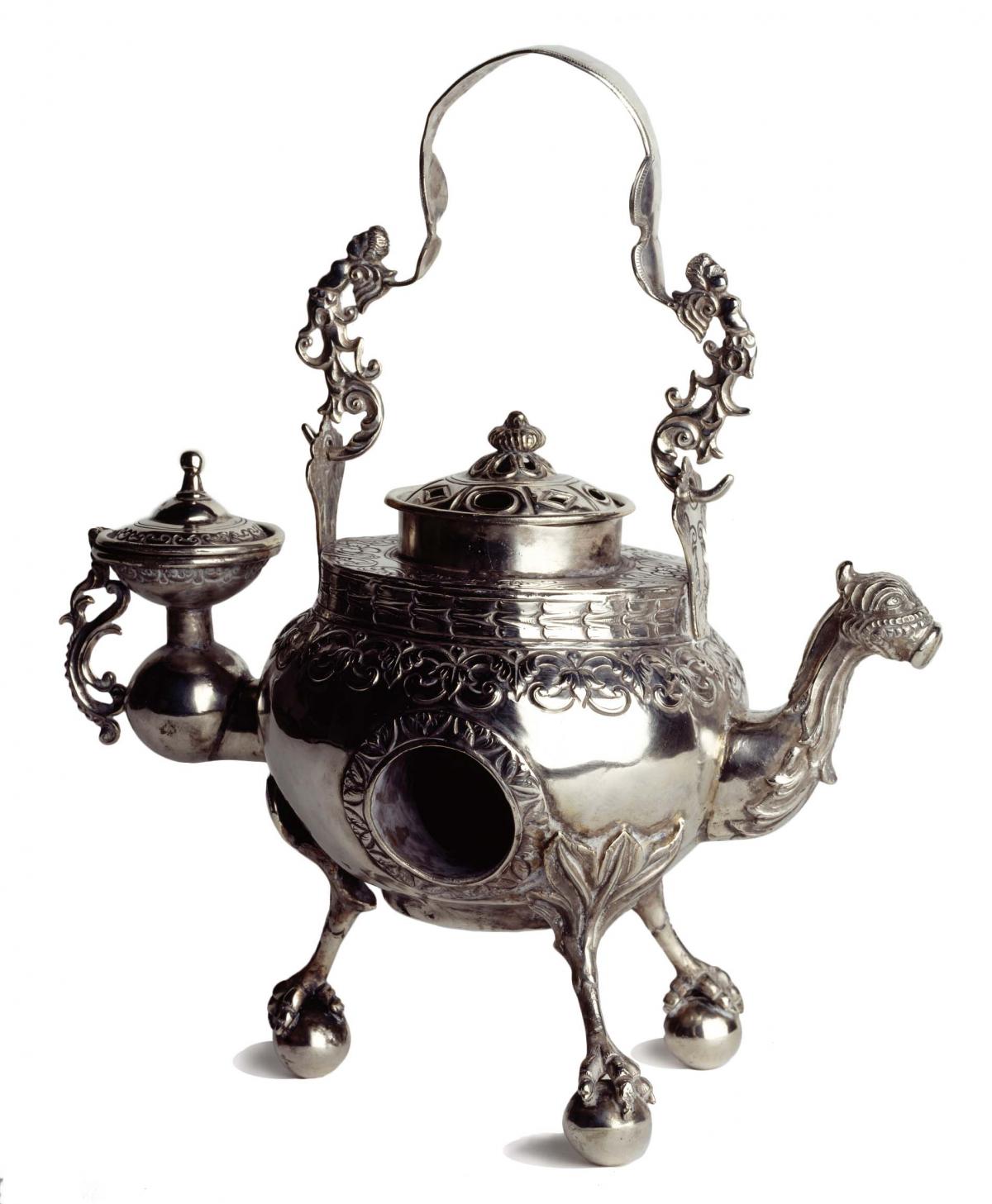At first glance, the portrait appears to be George Washington with a paunch and a sharp nose. The standard costume is there: white vest and britches, a navy coat trimmed in red, powdered wig, bright blue eyes, and a jauntily perched tricorne. The picture is dated 1790, putting it in the right era. Look closer, though, and you start to notice clues that this fellow was actually a high-ranking Creole official. A gold key with a red ribbon peeks out from the coat pocket, symbolizing his appointment as a Gentleman of the Royal Chamber of His Majesty, Charles III. There’s a family crest in the upper right, showing ties to four Spanish noble houses. In the lower left, a cartouche bears a cavalcade of titles. He is Count of Santiago de Calimaya, Don Juan Lorenzo Gutiérrez Altamirano de Velasco y Flores.
Don Juan Lorenzo was a descendant of one of the men who accompanied Hernán Cortés when he claimed Mexico from the Aztecs. His family built a grand palace in Mexico City and founded the first university in North America. But, as a Creole, a Spaniard born in America, he was barred from high civic and ecclesiastical offices. Spaniards from the higher castes looked down upon those born across the Atlantic, even if their bloodlines were pure. Don Juan Lorenzo pursued a military career, the one arena where he could advance without impediment, becoming a captain in the viceregal palace guard and one of the highest-ranking Creoles in New Spain. He also became rich enough to commission a portrait announcing his success to all who entered his home.
Mariano Guerrero’s portrait of Don Juan Lorenzo opens the Brooklyn Museum’s new exhibition, “Behind Closed Doors: Art in the Spanish American Home, 1492–1898,” which delves into the luxurious world created by the elite of Spanish America. Shortly after Christopher Columbus set foot in the Bahamas, Spain forged a colonial empire in North and South America. New Spain (1535–1821) ran from present-day Washington State southeast through Louisiana, then down through Latin America. From palaces in Mexico City, the viceroys also governed the Caribbean and the Philippines. New Peru (1543–1824), which initially encompassed much of South America, was governed from Lima.
Colonization brought an influx of Spaniards, as men and women braved the months-long ocean crossing to make fortunes, serve the crown, and spread Christianity. Some came and left, departing after a quick score or fulfilling an obligation to the crown. Others stayed, amassing fortunes from pearls, silver, tobacco, sugar, cattle, and slaves that could be passed on to successive generations. Protective of its holdings, the crown enacted policies to ensure that its handpicked emissaries maintained Spain’s hold on the region.
Public life was tightly regulated, so the elite of New Spain and Peru created private spaces that better reflected their wealth and status. They outfitted homes in fine tapestries, furniture tipped with gold leaf, elaborate silver services, and treasures imported from Europe and Asia. They dressed in the latest fashions, donning silk and lace. They knew a degree of luxury that rivaled the decadence of Paris and Vienna. Their conspicuous consumption expressed economic power. No visitor from Madrid could fail to take notice.
The Brooklyn Museum has been methodically collecting objects from New Spain and Peru since 1934, when it acquired a portrait by Francisco de Goya of Don Tadeo Bravo de Rivero, a Creole nobleman. Seven years later, it purchased approximately fourteen hundred objects from eight Latin American countries, some of which were featured in a groundbreaking exhibition entitled “America South of U.S.” After World War II, the museum continued collecting with the help of Nelson A. Rockefeller and others. Notable additions included an intact collection of household goods representing generations of a single Mexican family and a series of portraits, including the one of Don Juan Lorenzo, that serve as exemplars of Spanish colonial painting. In 1995, the museum acquired a portrait series depicting the Inca kings who had once ruled Peru.
Throughout New Spain and Peru, the walls of the upper class were filled with portraits of ancestors near and long dead. In the days before photography, a portrait captured the physical essence of a loved one (with perhaps a brushstroke or two of kindness), while also conveying information about rank and familial legacy. For status-conscious elites, nothing proclaimed their heritage faster than a wall of ancestors. Cartouches with title listings were a convenient and direct way to document achievements, but more subtle cues were used as well. Goya’s somewhat moody painting of Don Tadeo Bravo from 1806 follows this understated approach. A gray dog sits at Don Tadeo’s feet, gazing up at his master in a display of fidelity, while the lapel of his master’s gold-trimmed red coat bears the emblem of the Order of Santiago, a noble hereditary military order. The son of a Peruvian judge, Don Tadeo Bravo served in the Royal Infantry of Lima and as an administrator in Madrid. Like Don Juan Lorenzo, he was a Creole who climbed the military ranks to prominence.
In the pale blue anteroom that opens the exhibition, the paintings of Don Juan Lorenzo and Don Tadeo Bravo hang across from each other. Between them hangs a mosaic of the fourteen portraits of the Inca kings, painted in the mid eighteenth century. The square-shaped canvases glow from the gold used to paint the kings’ jewelry and headdresses. After Spain conquered the Inca Empire, indigenous noble families sought refuge in the newly established viceroyalty of Peru. Some Inca families formed alliance with Spain in exchange for titles and property, while others made strategic marriages. Indigenous elites ranked below Creoles on the social scale, but descendancy from a once powerful empire still had cachet. Scholars believe the portraits hung in the home of an elite Indian family in Cuzco, announcing the owner’s connection to Peru’s royal blood. Of course, the lively faces of the kings are the invention of the artist, as he had no way of knowing what they looked like. That the portraits survived to hang in Brooklyn today is testament to their owners’ resolve. In the wake of the Rebellion of Túpac Amaru II (1780–1781), an uprising that left 80,000 Indian and mestizo peasants dead, Spain outlawed any display of sympathy toward the Incas.
Upon entering the main gallery, you are surrounded by striking ruby red walls, as if walking into a jewel box. Your plunge into luxury has just begun. Elite homes tended to be modest on the outside, so as not to compete with church or government buildings. Inside, however, was a different story.
A new batch of portraits appears, and this time they include women who are holding court in lavish dresses. Although separated from Europe by a fickle ocean and thick expanses of jungle, women of means in New Spain and Peru could keep up with the latest court fashions through illustrations printed in pamphlets and fashion plates. Never mind that the punishing heat and humidity made wearing a chemise,corset, layers of petticoats, and heavily embroidered silk dresses a form of corporeal punishment. The women could have adopted a more cl imate-friendly approach to dress, but that would have meant sacrificing appearances. And it's not as if these ladies would later have to wash the sweat stains from their gowns. They had servants or slaves for that.
In Miguel Cabrera’s portrait of her, Doña María de la Luz Padilla y Gómez de Cervantes, ca. 1760, wears a corseted white silk brocade dress with intricate gold embroidery trimmed in Flemish lace. An elaborate pendant floats from a strip of black velvet tied about her neck. Her hair is powdered white and artificial birthmarks of varying size dot her left temple and cheekbone and the right side of her mouth. Despite being thousands of miles from Europe, Doña María engaged in the craze popular among fashionable women of applying false birthmarks, either by drawing them on or by gluing small bits of black velvet to their faces. According to a courtship manual published in Madrid in 1764, women used the spots to announce the state of their love life. “The beauty spots on the left temple may signify that the fortress is occupied; on the right temple, that she is on the point of breaking up with the current escort and ready to choose another; and the absence of the beauty spots on either temple may mean that the place is vacant.” Doña María’s fortess, it seems, is occupied.
Another portrait, this one of the Countess of Monteblanco and Montemar, Doña Rosa María Salazar y Gabiño, ca. 1770, showcases a woman draped with jewels. A diamond tiara perches upon carefully rolled and powdered hair. Large teardrop pearls hang from her chandelier earrings, while a cascade of pearls fall from the pin at her waist. An elaborate gold and silver necklace rests on a span of décolletage framed by the square neckline of her pink silk gown. So prominent are the jewels that it takes a second look to notice the intricate vine embroidery on the skirt and bodice, along with the tiers of lace finishing her sleeves. The heraldry over her left shoulder suggests that the portrait was painted to mark her marriage. As the daughter of the mayor of Lima, Doña Rosa would have been a good catch.
Though lovely to behold, these colonists were sometimes seen as courtier wannabes. François Raymond Joseph de Pons, a French government official who traveled through South America in the early 1800s, found much to appreciate about the women of Caracas, Venezuela, but noticed an unattractive side. “Their attire is rather elegant. They feel a kind of vanity on being taken for French; but, whatever resemblance there may be in the dress, there is too little in the gait, the step, and the grace to permit the illusion to subsist.”
And what is the Spanish word for dandy? In another portrait by Cabrera (see cover), which dates from around 1752, the Count of Santiago de Calimaya sports a coat, vest, and britches made of heavily embroidered silk. An interlocking pattern of blue and gold scrolls cascade across his black coat and pants. A vibrant garden of flowers ranging from roses to orchids grows on his massive claret-colored cuffs, as well as a vest in the same shade. Even his tricorne, propped under his left arm, receives similar attention. To finish the outfit, the count wears crimson red stockings in the same shade as the roses embroidered on his cuffs.
To help you understand the decadence of Spanish Colonial portraiture and the garments worn by its subjects, the exhibition includes portraits from British America from the same era. Next to the belles of New Spain and Peru, the women of New England, even under the brush of John Singleton Copley and Gilbert Stuart, look puritanical by comparison. This juxtaposition of items from Colonial Spain with British America runs throughout the exhibition and makes for a stunning contrast.
Now on intimate terms with your hosts—and perhaps aware of how underdressed and lacking in jewels you are—the exhibition beckons you further into the house. The items on display are organized around entertaining, letter writing, and worship. The carpets are plush, the chests are leather and painted with allegories. More scenes from the Bible appear along the walls in paintings displayed in heavy silver frames. Low-slung chairs with carved arms and legs are upholstered in heavy damask or cordovan leather. Elaborate designs of ivory, tortoise, and mother-of-pearl adorn the drawers and frames of chests. We also peek into a noble bedroom, where a magnificent carved bedframe painted in gold serves as the centerpiece.
The craftsmanship is marvelous, and the fondness for gold and silver a little overwhelming. De Pons felt the same way. “The eye wanders also over tables with gilded feet; chests of drawers, on which the gilder has exhausted all the resources of his art; brilliant lustres, suspended in the principal apartments; cornices which seem to have been dipped in gold; and rich carpets, covering at least all that part of the room where the seats of honor are placed.”
Colonial Spanish interiors were assembled from goods imported from Europe, the Middle East, Asia, as well as items produced locally to mimic coveted styles. This global approach to interior design was made possible by New Spain’s central location on the trade route between the Philippines and Spain. In Manila, Spanish galleons would fill their cargo holds with porcelain, carved ivory, folding screens, and silk before embarking for Mexico. Upon arrival in Acapulco, goods were unloaded, with some items sold locally and others carried overland to Veracruz. Galleons from Spain arrived in Veracruz bearing Flemish lace, cordovan leather, Italian damask, and other luxuries from Europe—provided they didn’t run afoul of pirates or get smashed to bits in a storm on the high seas. The empty holds were then filled with treasures from Asia, along with goods from the colonies for the voyage back. Money and patience allowed the elite to practice a form of globalism that seems absolutely modern.
A statue of the Virgin Mary from the eighteenth century, one of the loveliest objects in the exhibit, has Asian features and is made with ivory. A silver ribbon crown adorns her head. Her full skirts, whose wide sweep mimicked contemporary fashion, are made of cloth gessoed and painted to look like embroidered silk. The extraordinary piece would have been assembled in the Americas and displayed prominently in an elite home as a testament to the owner’s faith and wealth.
The collision of cultures is also apparent in a folding screen that is one of the showstoppers of the exhibition. Commissioned in 1700, most likely for display in the viceregal palace in Mexico City, the screen was made by local artisans, who studied illustrations of paintings and tapestries from Europe to capture the style of the day. The artists also used enconchado, an indigenous technique that combines mother-of-pearl inlays with painting, giving added depth to the figures and causing the screen to shimmer as if set with jewels. One side of the screen depicts battle scenes from the Great Turkish War (1683–99) between the Hapsburgs and Ottomans, including the Siege of Belgrade, while the flip side portrays noblemen hunting boar and deer. The screen is a piece of Asian furniture that uses local Mexican techniques to celebrate a Habsburg victory.
An array of serving pieces has also survived, triumphing over time and scullery maids with sticky fingers. Elite women entertained in the afternoons, inviting friends over for hot chocolate or maté. The passion for chocolate rivaled the mania for fine clothing, leading to ornate table settings. Porcelain pieces imported from England and China, featuring patterns ranging from pastoral scenes to fierce dragons, were laid out on specially designed serving tables. Silver was used for platters, utensils, water heaters, and pitchers. Often produced locally, the designs might copy European trends or play with the iconography of the region. A whimsical water heater, which dates from eighteenth-century Bolivia, features a dragon’s head for the spout. Clawed feet turn into leaves, while the handle climbs upward in a series of interlocking scrolls.
Those who could afford it commissioned china services to be made for both use and display. Ships sailing to Manila carried the orders, where they were passed off to Chinese merchants, who arranged for artisans in Canton to manufacture the china from detailed drawings. Upon completion, the china would be packed up for the perilous voyage to New Spain or Peru, where it would arrive, if luck held, with only minimal breakage. In a china service created for Ignacio Gómez Cervantes, a nobleman from Mexico, his family crest—a vibrant illustration done in gold, turquoise, and rose—decorates the center of a plate, the side of a teacup, and the body of pitcher. The plates and saucers also have scalloped edges ornamented with a delicate gold-cross pattern.
As you walk through this decadent domestic world that the elites of New Spain and Peru created, marveling at the beautiful things laid out before you, it is hard not to pause now and then to consider the source of the money for such lavish displays of wealth. Those engaging portraits? Depictions of men and women who enabled Spain’s governance of New Spain and Peru. That gorgeous dishware? It served dinner to men who put down peasant rebellions and slave uprisings. Each platter, painting, and piece of silk was purchased through the labor of peasants and slaves. This was a world grounded in colonialism, in the economic and military subjugation of indigenous populations. This brilliant exhibition offers a tour of the lifestyles of the rich Spanish colonial, but it also serves as a tour of the mindset that helped maintain an empire for four hundred years.










